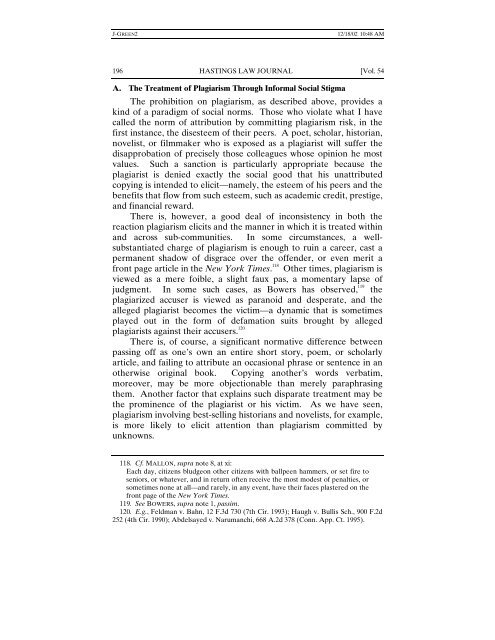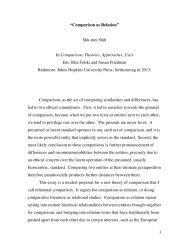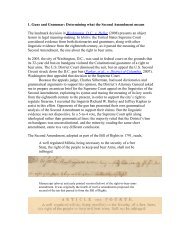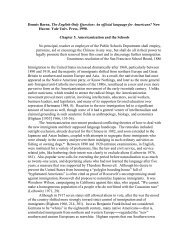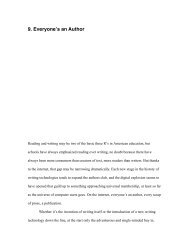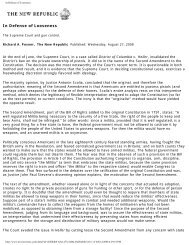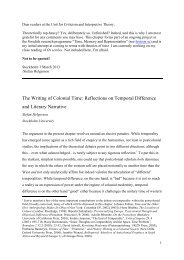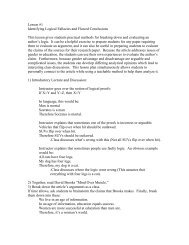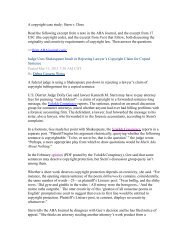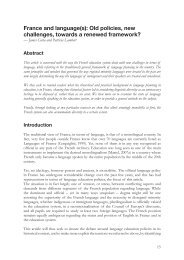Plagiarism, Norms, and the Limits of Theft Law: Some ... - English
Plagiarism, Norms, and the Limits of Theft Law: Some ... - English
Plagiarism, Norms, and the Limits of Theft Law: Some ... - English
Create successful ePaper yourself
Turn your PDF publications into a flip-book with our unique Google optimized e-Paper software.
J-GREEN2 12/18/02 10:48 AM<br />
196 HASTINGS LAW JOURNAL [Vol. 54<br />
A. The Treatment <strong>of</strong> <strong>Plagiarism</strong> Through Informal Social Stigma<br />
The prohibition on plagiarism, as described above, provides a<br />
kind <strong>of</strong> a paradigm <strong>of</strong> social norms. Those who violate what I have<br />
called <strong>the</strong> norm <strong>of</strong> attribution by committing plagiarism risk, in <strong>the</strong><br />
first instance, <strong>the</strong> disesteem <strong>of</strong> <strong>the</strong>ir peers. A poet, scholar, historian,<br />
novelist, or filmmaker who is exposed as a plagiarist will suffer <strong>the</strong><br />
disapprobation <strong>of</strong> precisely those colleagues whose opinion he most<br />
values. Such a sanction is particularly appropriate because <strong>the</strong><br />
plagiarist is denied exactly <strong>the</strong> social good that his unattributed<br />
copying is intended to elicit—namely, <strong>the</strong> esteem <strong>of</strong> his peers <strong>and</strong> <strong>the</strong><br />
benefits that flow from such esteem, such as academic credit, prestige,<br />
<strong>and</strong> financial reward.<br />
There is, however, a good deal <strong>of</strong> inconsistency in both <strong>the</strong><br />
reaction plagiarism elicits <strong>and</strong> <strong>the</strong> manner in which it is treated within<br />
<strong>and</strong> across sub-communities. In some circumstances, a wellsubstantiated<br />
charge <strong>of</strong> plagiarism is enough to ruin a career, cast a<br />
permanent shadow <strong>of</strong> disgrace over <strong>the</strong> <strong>of</strong>fender, or even merit a<br />
front page article in <strong>the</strong> New York Times. 118 O<strong>the</strong>r times, plagiarism is<br />
viewed as a mere foible, a slight faux pas, a momentary lapse <strong>of</strong><br />
judgment. In some such cases, as Bowers has observed, 119 <strong>the</strong><br />
plagiarized accuser is viewed as paranoid <strong>and</strong> desperate, <strong>and</strong> <strong>the</strong><br />
alleged plagiarist becomes <strong>the</strong> victim—a dynamic that is sometimes<br />
played out in <strong>the</strong> form <strong>of</strong> defamation suits brought by alleged<br />
plagiarists against <strong>the</strong>ir accusers. 120<br />
There is, <strong>of</strong> course, a significant normative difference between<br />
passing <strong>of</strong>f as one’s own an entire short story, poem, or scholarly<br />
article, <strong>and</strong> failing to attribute an occasional phrase or sentence in an<br />
o<strong>the</strong>rwise original book. Copying ano<strong>the</strong>r’s words verbatim,<br />
moreover, may be more objectionable than merely paraphrasing<br />
<strong>the</strong>m. Ano<strong>the</strong>r factor that explains such disparate treatment may be<br />
<strong>the</strong> prominence <strong>of</strong> <strong>the</strong> plagiarist or his victim. As we have seen,<br />
plagiarism involving best-selling historians <strong>and</strong> novelists, for example,<br />
is more likely to elicit attention than plagiarism committed by<br />
unknowns.<br />
118. Cf. MALLON, supra note 8, at xi:<br />
Each day, citizens bludgeon o<strong>the</strong>r citizens with ballpeen hammers, or set fire to<br />
seniors, or whatever, <strong>and</strong> in return <strong>of</strong>ten receive <strong>the</strong> most modest <strong>of</strong> penalties, or<br />
sometimes none at all—<strong>and</strong> rarely, in any event, have <strong>the</strong>ir faces plastered on <strong>the</strong><br />
front page <strong>of</strong> <strong>the</strong> New York Times.<br />
119. See BOWERS, supra note 1, passim.<br />
120. E.g., Feldman v. Bahn, 12 F.3d 730 (7th Cir. 1993); Haugh v. Bullis Sch., 900 F.2d<br />
252 (4th Cir. 1990); Abdelsayed v. Narumanchi, 668 A.2d 378 (Conn. App. Ct. 1995).


